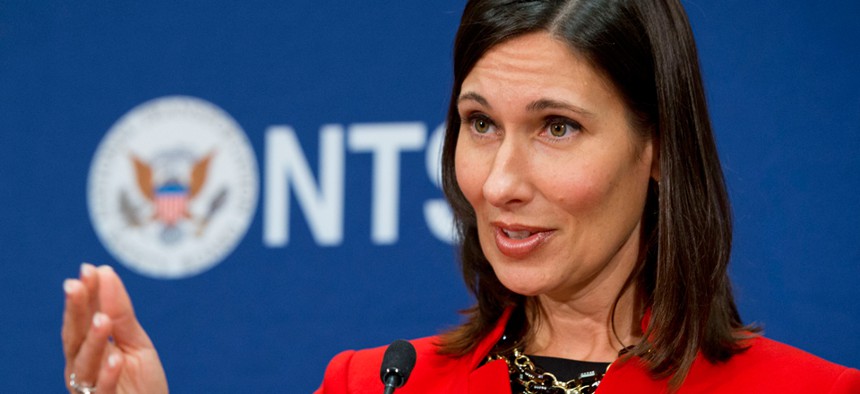
"People expect some things from good government, and improving standards of safety is one of them,” Deborah Hersman said. Jacquelyn Martin/AP file photo
Outgoing NTSB Chief: People Expect Government to Make Traveling Safer
Hersman asks media to keep safety in the news, pushes for child restraints on planes.
In a sometimes-emotional farewell speech, the outgoing National Transportation Safety Board chairwoman told reporters that their continued coverage of lessons from fatal accidents is vital to helping government manage risks and build safety practices into everyday routine.
Deborah Hersman, whose 10 years at the board ends April 25, told a Monday breakfast at the National Press Club in Washington that “people expect some things from good government, and improving standards of safety is one of them.”
In a review of modern-day airline tragedies, Hersman pushed for forward progress on her independent agency’s “Most Wanted List” of unimplemented safety improvements. “Yesterday’s tragic lesson is today’s safety step and tomorrow’s unacceptable risk,” she told reporters.
A key item on that list is a NTSB call dating from March 2001 for commercial airplanes to require seat restraints for passengers of all ages during takeoff and landing, turbulence and a crash scenario. “Ironically,” the list text reads, “we are required to stow our luggage, and small bags, and even the snacks and beverages served during flight, yet the Federal Aviation Administration exempts the most vulnerable passengers, children under age 2, allowing them to travel unrestrained, on an adult's lap.”
Hersman said the current-era debate over child restraints stems from the 1989 crash of United Flight 232 in Sioux City, Iowa, in which 111 passengers died and 185 were saved when the DC 10 plane cartwheeled during an emergency landing that put the aircraft operating on only two good engines in a cornfield. As stunned passengers roamed the fiery wreckage looking for their companions, Hersman said, a key issue that emerged was the requirement that flight attendants enforce a rule that small children be on the floor and not on parents’ laps. “We secure laptops and coffee pots, but not the most precious cargo of children,” said Hersman.
A flight attendant who survived that crash, Jan Brown Lohr, was introduced from the head table during Hersman’s speech, and the NTSB chair praised Lohr's work lobbying for new regulations requiring small children’s safety belts.
One of the heroes from that incident, Hersman continued, later said his actions to save one baby were what anyone would have done. In a long allegory, she then described a mountain kingdom in which the village elders were raised to the top in a rope basket, but where observers can see that some “ropes have frayed.”
Contrary to “social Darwinism,” Hersman said, the human brain has evolved from the cave days—when predators threatened fellow humans and food supplies—to be “wired” so that “once the rope is frayed, we can’t let it break.” The Spanish word for “sorry means ‘I feel it,’ ” she said. “That’s not just a colorful phrase but human beings at their core. We’re hardwired for empathy.”
Asking the audience to think back on their first editor or boss, she noted that most reported bad memories, “and bad memories stick,” she said. Hence from transportation tragedies come efforts to steer human behavior to “mirror” safety procedures, as defined in such tools as international safety agreements and new precautions. Journalists, she added, citing the drama of the sinking of the Titanic in 1912, help keep society’s eyes on such mirrored behavior.
The past four years have seen only a “handful” of domestic aviation deaths, Hersman noted, comparing that against highways deaths that continue to average 30,000 annually. The most recent U.S. airline accident was the July 6, 2013, crash of an Asiana Boeing 777 at San Francisco International Airport that killed three. A NTSB report on that tragedy is due out the summer, Hersman said, adding her hope that the result will be new preventative steps involving pilot training and technology.
NEXT STORY: Commentary: The Power of Mission vs. Dysfunction







